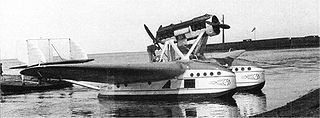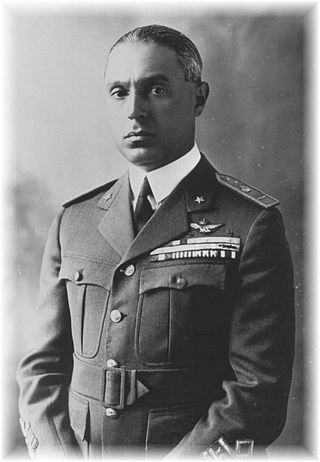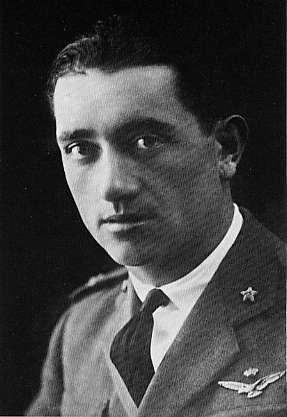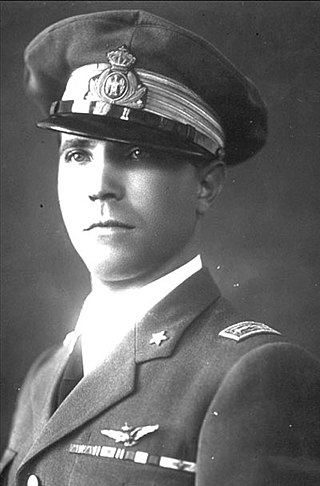
Italo Balbo was an Italian fascist politician and Blackshirts' leader who served as Italy's Marshal of the Air Force, Governor-General of Italian Libya and Commander-in-Chief of Italian North Africa. Due to his young age, he was sometimes seen as a possible successor of dictator Benito Mussolini.
This is a list of aviation-related events from 1928:

The Savoia-Marchetti S.55 was a double-hulled flying boat produced in Italy, beginning in 1924. Shortly after its introduction, it began setting records for speed, payload, altitude and range.
SIAI-Marchetti was an Italian aircraft manufacturer primarily active during the interwar period.

Francesco de Pinedo was a famous Italian aviator. A Regia Marina officer who transferred to the Regia Aeronautica, he was an advocate of the seaplane and is best known for his long-range flying boat flights in the 1920s that demonstrated the feasibility of global air travel.

Alessandro Guidoni served as a general in the Regia Aeronautica. Guidonia Montecelio, the small town and comune where he died while testing a new parachute, was named after him in 1937.

Leonardo Ferrulli was an ace of the Regia Aeronautica, and a recipient of the Medaglia d'Oro al Valor Militare. He was credited with 22 air victories, one during the Spanish Civil War and 21 during World War II. He shot down Hurricanes, P-40s, P-38 Lightnings, Spitfires and B-17s, flying Fiat C.R.42 biplanes and Macchi C.200/202 monoplanes. His unit was 91a Squadriglia, 10° Gruppo, from 4° Stormo, one of the top-scoring fighter units of Regia Aeronautica.
Franco Lucchini, MOVM, was an Italian World War II fighter pilot in the Aviazione Legionaria and in the Regia Aeronautica. During World War II he achieved 21 individual air victories, plus 52 shared, to add to the five kills in Spain, during the Civil War.

Tommaso Dal Molin was an Italian fighter pilot and internationally prominent seaplane air racer and aerobatic pilot of the 1920s.
Mario Aramu was an Italian aviator.

Umberto Klinger was an aviator, Italian politician and entrepreneur.

Antonio Lippi was an Italian aviator. He participated in the transatlantic flight organized by Italo Balbo and was awarded the Gold Medal of Aeronautic Valor of the Regia Aeronautica.
The Medal of Aeronautic Valor is an Italian medal awarded "for acts and enterprises of singular courage and skill aboard an aircraft in flight." Instituted in 1927, it is awarded at three levels: Gold, Silver and Bronze. The medal may be conferred on both Italian and foreign persons and entities and on both civilians and members of the Italian armed forces. It can also be awarded posthumously.

The Decennial Air Cruise was a mass transatlantic flight from Orbetello, Italy, to the Century of Progress International Exposition, Chicago, Illinois. The expedition, organized by the Italian Regia Aeronautica, began on July 1, 1933, and ended on August 12 of the same year. It consisted of 25 Savoia-Marchetti S.55X seaplanes crossing the Atlantic Ocean in formation, forming the greatest mass flight in aviation history. The Italian Squadrons, led by General Italo Balbo, were welcomed enthusiastically in the Netherlands, the UK, Iceland, Canada and particularly in the United States of America, where they became known as the Italian Air Armada. A publicity success for Fascist Italy, Balbo further viewed the expedition as a pioneering step towards commercial flights across the Atlantic.
Atlantic Flight is a 1931 short documentary film made by the Regia Aeronautica Italiana, based on the pioneering 1930 transatlantic formation flight made by 12 Savoia-Marchetti S.55 flying boats, commanded by General Italo Balbo. Atlantic Flight is notable as the first Italian aviation film.

Aldo Pellegrini was an Italian Air Force general during World War II.

Attilio Biseo was an Italian aviator, powerboat racer, Air Force general during World War II, and the personal pilot of Benito Mussolini during the 1930s.

Eraldo Ilari was an Italian Air Force general during World War II. He was commander of the 4th Air Fleet in Apulia and later of the 3rd Air Fleet in central Italy.

Giuseppe Valle was an Italian Air Force general during the interwar period, Chief of Staff of the Regia Aeronautica from 1928 to 1939 and State Undersecretary for the Air Force from 1933 to 1939. He was also a member of the Chamber of Fasces and Corporations.
Ruggero Bonomi was an Italian Air Force general during the Spanish Civil War and World War II. He was deputy commander of the Corpo Aereo Italiano and commander of the Auxiliary Naval Air Force; after the Armistice of Cassibile he became the last State Undersecretary for the Air Force of the Italian Social Republic.













